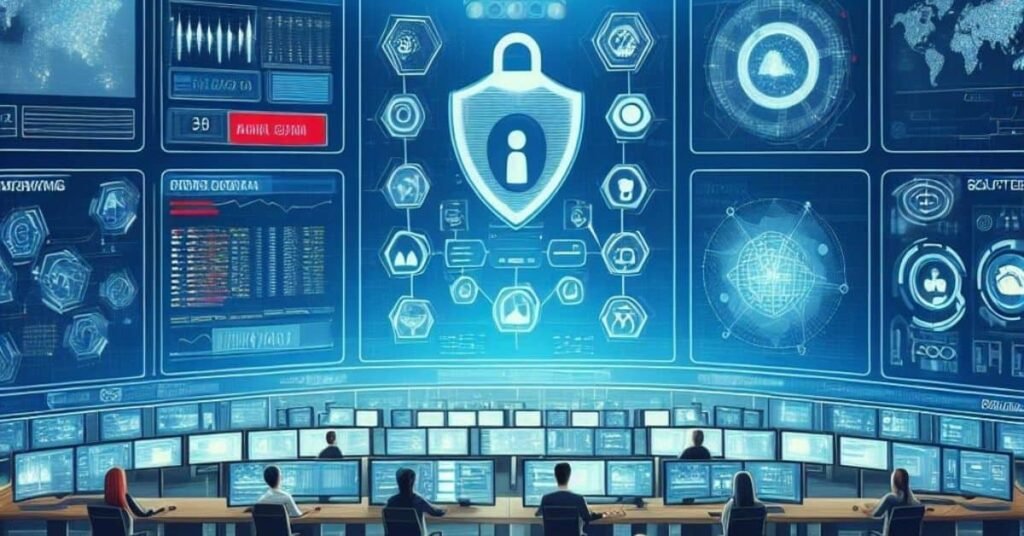What is SIEM ?
SIEM stands for Security Incident Event Management.
SIEM is like a super detective for companies. It helps find and tell about possible problems with security before they cause big trouble.
For a moment, imagine that you have a very large computer system that stores all kinds of information in it, lets you know about how someone has logged in and tried to access the files, and informs you about the intruder who tries to break into your system. So, what will SIEM do here? SIEM will provide you guaranteed security by monitoring the computer system.
SIEM owns the ability to gather up information from various connected devices, tools used for security, and even servers. It will immediately detect something suspicious going on if the files are being accessed from a suspicious location, or there is someone who has tried to enter by entering wrong passwords in a row. SIEM‘s work can be compared with that of a detective’s work, who is always looking for clues to solve a mystery.
SIEM is perfect at spotting suspicious activity and alerting the IT experts for an immediate action. We can consider it as a guard who patrols the areas in search of any suspicious activity going on and reports to take actions if any potential threat that might harm the computer system is identified.
SIEM systems:
- Identifies abnormalities in an user’s behaviour
- Automatizes the manually working procedures associated with detection of a threat and response of an incident
- It combines the working of both Security Event Management (SEM) and Security Information Management (SIM) systems
- It does real-time supervision and analyses the events relevant to security
- It also helps in tracking and logging of secured information for auditing process and compliance
- Moreover, with the passage of time this software has further been enhanced to unite:
- User and Entity Behavior Analytics (UEBA)
- Analytics of advanced security, Artificial Intelligence, and ability of machine learning to recognize suspicious behaviours and advanced risks
- In many modern Security Operation Centers, SIEM can be seen used as a tool that holds the processes of compliance management system and security monitoring together.
How Does SIEM Work?
The main function of the SIEM is to gather different types of data, consolidate, and perform specific functions to recognize threats and stick to the processes that are required in compliance management.
Key functions include:
- Gathering of Data: It is responsible for collecting several event log data from many sources from the IT organisation’s premises.
- Connection of an event: SIEM owns the ability to utilise analytics to understand the patterns of data and instantly find and report the potential threats
- Real-time Identification: It helps in the analysis of data in real-time so that the mean time to detect (MTTD) and the mean time to respond (MTTR) are acknowledged
- Incorporation with Hazard Intelligence Feeds: It can correlate internal data of security against signatures and profiles of a threat.
This type of solution even has its own dashboard where a security team supervises threats, sends alerts, and takes immediate actions whenever suspicious events occur.
SIEM as a Service (Managed SIEM)
Managed SIEM consists of a set of combined security amenities, management of logs and supervision tools. It offers us real-time response during an incident and detects risks.
Benefits:
- A rapid detection is observed when data is breached or threats occur.
- Focuses on solutions to provide when there is threat detection and automatizes security log information.
- Managed Security Service workers are the ones who provide SIEM to different companies.
Components of SIEM as a Service

This system serves the purpose of a very important system which protects networks against cyberattacks. It is a combination that is formed using two functions: Security Information and Security Event Management. Lest take look at the crucial elements of SIEM framework:
Data Aggregation:
This component is responsible for collecting data from many sources within a communal network. Those sources may include servers, firewalls, databases, routers, cloud systems and applications. Recording of all events is done by Logs within a specific device or application
SIEM employs different log collection techniques:
- Agent based Log Collection: There is involvement of agents on network devices that collect logs are responsible for sending the logs to servers belonging to SIEM. Before forwarding the log data to servers, the agents may filter, analyse and format it.
- Agentless Log Collection: Changes brought in configuration may allow various devices to forward their log data to SIEM servers, but without the employment of agents.
- API-based Log Collection: Logs are directly collected by the SIEM system from network devices utilising the APIs, this can take place from cloud systems and virtual machines as well.
Security Data Analytics (Reports and Dashboards)
- A security analytics component is also present within the SIEM solutions
- Security data is represented very clearly in the form of graphs and charts by dashboard
- These analytics facilitate real-time supervision, analyse events and sustain security logs for reviewing and compliance purposes
Thing to notice: SIEM warrants protection against cyber-attacks through continuous supervision and identification of events related to network and data.
Cost-Effectiveness:
- SIEM as a great service hinders the need to invest in large organisations and maintains hardware, software and framework on premises.
- It is a model working on the basis of subscription, permitting companies to pay just for the services they utilise
- This strategy might come in handy for those small and medium sized businesses which operate on a budget.
Scalability and Flexibility:
- SIEM services that are based on a cloud can easily be ranged up or down based on a company’s demands
- These services can also be enhanced without any further investment when a business grows or goes through alterations in experience
- Companies can add or eliminate resources of logs, adjust capacity of the storage, and extend coverage as required
Rapid Deployment and Reduced Maintenance Burden:
- SIEM can be deployed very quickly, especially in comparison to setting up and configuring its solution on premises.
- Service providers deal with updates, patches of security, maintenance, and free up IT workforce to bring other important tasks into focus
Access to Proficiency and Risk Intelligence:
- Services offered by Managed SIEM often come with a workforce of experts who monitor, and analyse events regarding security
- These experts offer valued visions, threat recognition, and event response
- Moreover, these services mix with feeds of risk intelligence, improving the company’s ability to recognize and respond to threats appearing
Improved Security Posture:
SIEM services constantly screen logs and incidents, identifying abnormalities, activities that are odd, and potential security events. Real-time alarms allow companies to act punctually to threats, decreasing damage
Reduced Complexity:
- This service streamlines the placement procedure, making it available to companies without dedicated security workforce
- The one who provides service deals with difficult tasks like collection of log, connection, and analysis
Geographical Redundancy and Disaster Recovery:
- Geographical dismissal is provided when cloud-based SIEM services work across various data centres.
- In case of a disaster or catastrophe, the service can smoothly shift to a changed location, making sure of the constant supervision and protection .
Conclusion
In Conclusion, this service is inexpensive, offers scalability, good support, and enhanced security, making it a captivating route for companies seeking vigorous hazard detection and event response abilities.
FAQs
Some Frequently asked questions are as following:
How does SIEM differ from traditional SIEM solutions?
The old way of using SIEM needs a lot of money upfront for computers, programs, and keeping everything working. But with SIEM as a Service, it’s like using a game that’s stored on the internet instead of your own computer. You don’t need to buy and take care of special equipment, and you can make it bigger or smaller easily.
How does SIEM as a Service improve security posture?*
It helps to make things safer by always checking on computers and networks, noticing if anything weird is happening, and telling us right away. This makes it easier to respond quickly to any problems and follow the rules that are there to keep everything safe.
What are the advantages of choosing SIEM as a Service over managing SIEM in-house?
It’s like renting a video game instead of buying it. You don’t have to pay a lot of money upfront, and you can change how big or small the game is whenever you want. It’s easier to keep the game working well and get new updates. You also get extra help to keep the game safe, see what’s happening in the game, and follow the game’s rules.
How does pricing for SIEM as a Service work?
The cost of using SIEM as a service can change depending on the company you choose. It usually depends on how much information is used, how many people or devices are watched, and what extra things or help you need. Some companies ask for a fixed amount every month, while others charge more if you use a lot.
Is SIEM suitable for multi-cloud environments?
SIEM is like a security superhero that can keep an eye on all your computer stuff, whether it’s in the cloud or on your own computer. It looks at everything together to make sure nothing bad is happening, so you can see all the computer things in one place and know if something is wrong.
How can I get started with SIEM ?
To start using SIEM, you first need to choose a good SIEM company. Then, you look at what security things your organization needs. After that, you set up the SIEM to work the way you need it to. Finally, you install special tools to collect all the data for the SIEM to use.
